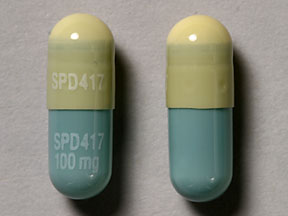Equetro Dosage
Generic name: CARBAMAZEPINE 100mg
Dosage form: capsule, extended release
Drug class: Dibenzazepine anticonvulsants
Medically reviewed by Drugs.com. Last updated on Oct 13, 2022.
2.1 Pretreatment Screening
Prior to initiating treatment with EQUETRO, test patients with ancestry in genetically at-risk populations for the presence of the HLA-B*1502 allele. The high resolution genotype test is positive if one or two HLA-B*1502 alleles are present. Avoid use of EQUETRO in patients testing positive for the allele, unless the benefit clearly outweighs the risk [see Boxed Warning, Warnings and Precautions (5.1)].
Complete pretreatment blood counts, including platelets and possibly reticulocytes and serum iron, should be obtained as a baseline. If a patient in the course of treatment exhibits low or decreased white blood cell or platelet counts, the patient should be monitored closely. Discontinuation of EQUETRO should be considered if any evidence of significant bone marrow depression develops [see Warnings and Precautions (5.2)].
Baseline and periodic evaluations of liver function, particularly in patients with a history of liver disease, must be performed during treatment with EQUETRO because liver damage may occur. Discontinue EQUETRO in cases of aggravated liver dysfunction or active liver disease [see Warnings and Precautions (5.10)].
Baseline and periodic eye examinations, including slit-lamp, funduscopy, and tonometry, are recommended since many phenothiazines and related drugs have been shown to cause eye changes [see Warnings and Precautions (5.13)].
Baseline and periodic complete urinalysis and BUN determinations are recommended for patients treated with this agent because of observed renal dysfunction.
2.2 Dosage for Acute Manic or Mixed Episodes Associated with Bipolar I Disorder
The recommended initial dose of EQUETRO is 200 mg administered twice daily. The dose may be increased by 200 mg per day to achieve optimal clinical response. Doses higher than 1600 mg per day have not been studied in mania associated with bipolar disorder.
2.3 Dosage for Pain of Trigeminal Neuralgia
Initial: On the first day, start with one 200 mg capsule once daily. This dose may be increased by up to 200 mg/day using increments of 100 mg every 12 hours only as needed to reach an effective and tolerated dose. Do not exceed a total daily dose of 1200 mg.
Maintenance: Control of pain can be maintained in most patients with 400 mg to 800 mg daily. However, some patients may be maintained on as little as 200 mg daily, while others may require as much as 1200 mg daily. At least once every 3 months throughout the treatment period, attempts should be made to reduce the dose to the minimum effective level or even to discontinue the drug.
2.4 Dosage for Epilepsy
Adults and Children over 12 Years of Age
The recommended initial dose is 200 mg administered twice daily. Increase in weekly increments of 200 mg a day, administered as an equally divided, twice daily dose, until an optimal response is obtained. Dosage generally should not exceed 500 mg twice daily in children 12 to 15 years old; 600 mg twice daily in children 15 to 18 years old; and 800 mg twice daily in adults.
Children Under 12 Years of Age
Ordinarily, optimal clinical response is achieved at daily doses below 35 mg/kg [see Dosage and Administration (2.5)]. No recommendation regarding the safety of EQUETRO for use at doses above 35 mg/kg/24 hours can be made.
Co-Administration with Other AEDs
EQUETRO may be used alone or with other AEDs. When added to existing AEDs, add EQUETRO gradually while the dosage(s) of other AEDs are maintained or gradually decreased. Potential drug interactions should be considered when using carbamazepine with other AEDs [see Drug Interactions (7.1, 7.2)].
2.5 Switching from Immediate-Release Carbamazepine to EQUETRO
EQUETRO is an extended-release formulation for twice a day administration. When converting patients from immediate release carbamazepine to EQUETRO extended-release capsules, the same total daily mg dose of carbamazepine should be administered. Following conversion to EQUETRO, patients should be closely monitored for seizure control. Depending on the therapeutic response after conversion, the total daily dose may need to be adjusted within the recommended dosing instructions.
2.6 Discontinuation of EQUETRO
When discontinuing EQUETRO used for any indication, reduce the dose gradually and avoid abrupt discontinuation in order to decrease the risk of seizure [see Warnings and Precautions (5.6)].
2.7 Monitoring Serum Carbamazepine Concentration
Monitoring serum carbamazepine concentrations may be useful for dose selection, minimizing toxicity, and verifying drug compliance, especially in clinical conditions in which alterations in EQUETRO metabolism can occur (e.g., drug interactions) [see Drug Interactions (7)]. In pediatric patients treated with EQUETRO for epilepsy, if satisfactory clinical response has not been achieved, measure plasma levels to determine whether or not they are in the therapeutic range.
More about Equetro (carbamazepine)
- Check interactions
- Compare alternatives
- Pricing & coupons
- Reviews (5)
- Drug images
- Side effects
- Dosage information
- During pregnancy
- FDA approval history
- Drug class: dibenzazepine anticonvulsants
- Breastfeeding
- En español
Patient resources
Other brands
Tegretol, Carbatrol, Tegretol XR, Epitol, Carnexiv
Professional resources
Other brands
Tegretol, Carbatrol, Epitol, Carnexiv
Related treatment guides
Further information
Always consult your healthcare provider to ensure the information displayed on this page applies to your personal circumstances.

